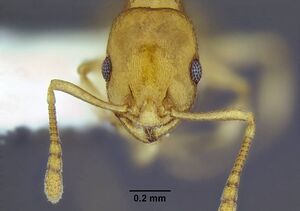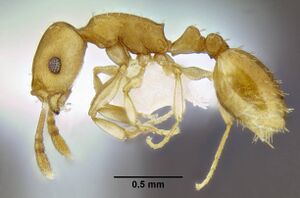Temnothorax pseudandrei
| Temnothorax pseudandrei | |
|---|---|

| |
| Scientific classification | |
| Kingdom: | Animalia |
| Phylum: | Arthropoda |
| Class: | Insecta |
| Order: | Hymenoptera |
| Family: | Formicidae |
| Subfamily: | Myrmicinae |
| Tribe: | Crematogastrini |
| Genus: | Temnothorax |
| Species group: | andrei |
| Species: | T. pseudandrei |
| Binomial name | |
| Temnothorax pseudandrei Snelling, Borowiec & Prebus, 2014 | |
Little is known of the ecology of this ant other than that it is an arboreal species. Specimens were taken from under the bark of desert willow (Chilopsis linearis) in habitat that is now a much fragmented riverine gallery forest. The habitat for some Arizona specimens is similar, but in this instance the specimens were nesting in the bark of Fremont cottonwood (Populus fremontii). No data are available for Resting Springs, CA specimens and they were presumably taken at lights at night. That habitat is not riverine, but originally there was a flowing spring and a substantial stand of Fremont cottonwood. The site has been commercially developed and most of the cottonwood trees are no longer there. (Snelling et al. 2014)
Identification
Prebus 2017 - A member of the andrei clade.
Snelling et al. (2014) - Mesosoma, petiole and postpetiole dull and contiguously punctate; head shinier, punctures larger, shallower and distinctly shiny within, without fine rugae except above frontal lobes and around antennal fossa; subpetiolar process short and broad.
As the name suggests, T. pseudandrei is similar to, and may be confused with, Temnothorax andrei, a common ground-dwelling species in California and neighboring states. Workers of T. pseudandrei differ by the short, broad subpetiolar process and the less robust, more acute petiolar node (Figures 20B, 21A). The worker of T. pseudandrei lacks erect setae on the underside of the head and the gyne has a single pair of very short flattened setae a short distance behind the oral cavity. Fine erect setae are present on the underside of the head in both workers and gynes of T. andrei. Additionally, the erect setae on the cephalic and mesosomal dorsa are shorter and less numerous.
Males of the two species are similar but differ in the length of the few setae present on the upper frons and vertex. In T. andrei there are about 10 setae, including 2 along the lateral margins and all are distinctly longer than the maximum diameter of the anterior ocellus. A few setae are also present on the underside of the head. Males of T. pseudandrei have about 6 setae on the vertex, none on the frons none along the lateral margins and none on the underside of the head. Those setae present on the vertex are only slightly longer than the greatest diameter of the anterior ocellus.
Keys including this Species
Distribution
Latitudinal Distribution Pattern
Latitudinal Range: 35.87° to 32.79°.
| North Temperate |
North Subtropical |
Tropical | South Subtropical |
South Temperate |
- Source: AntMaps
Distribution based on Regional Taxon Lists
Nearctic Region: United States (type locality).
Distribution based on AntMaps
Distribution based on AntWeb specimens
Check data from AntWeb
Countries Occupied
| Number of countries occupied by this species based on AntWiki Regional Taxon Lists. In general, fewer countries occupied indicates a narrower range, while more countries indicates a more widespread species. |

|
Estimated Abundance
| Relative abundance based on number of AntMaps records per species (this species within the purple bar). Fewer records (to the left) indicates a less abundant/encountered species while more records (to the right) indicates more abundant/encountered species. |

|
Biology
Castes
Worker
Images from AntWeb
    
| |
| Paratype of Temnothorax pseudandrei. Worker. Specimen code casent0005693. Photographer April Nobile, uploaded by California Academy of Sciences. | Owned by USNM, Washington, DC, USA. |
Queen
Images from AntWeb
   
| |
| Paratype of Temnothorax pseudandrei. Worker. Specimen code casent0005693. Photographer April Nobile, uploaded by California Academy of Sciences. | Owned by USNM, Washington, DC, USA. |
Male
Images from AntWeb
   
| |
| Holotype and paratype of Temnothorax pseudandrei. Queen (alate/dealate). Specimen code casent0339311. Photographer Marek Borowiec, uploaded by UC Davis Ant Group. | Owned by UCDC, Davis, CA, USA. |
Nomenclature
The following information is derived from Barry Bolton's Online Catalogue of the Ants of the World.
- pseudandrei. Temnothorax pseudandrei Snelling, Borowiec & Prebus, 2014: 64, figs. 14–16, 20, 24–25 (w.q.m.) UNITED STATES.
Unless otherwise noted the text for the remainder of this section is reported from the publication that includes the original description.
Description
Worker
measurements (mm) (12 measured): EL 0.121–0.152 (0.139); HFL 0.408–0.488 (0.442); HFW 0.095–0.109 (0.102); HL 0.577–0.648 (0.619); HW 0.454–0.514 (0.489); IOD 0.390–0.430 (0.413); OMD 0.134–0.155 (0.144); PPW 0.179–0.196 (0.188); PSL 0.049–0.080 (0.066); PTW 0.130–0.153 (0.145); PW 0.296–0.345 (0.324); SL 0.394–0.457 (0.432); WL 0.627–0.715 (0.675). Indices: CI 77.5–80.7 (79.1); FI 86.4–96.4 (90.4); OI 21.0–23.7 (22.4); PI 123–138 (130); PSI 7.73–12.6 (10.7); SI 68.3–71.0 (69.8).
Head longer than broad in frontal view; posterior margin mostly transverse but with small median impression; lateral margins very weakly convex and slightly convergent behind eyes. Antenna 12-segmented; scape short of posterior margin by slightly more than its apical width; apical club distinctly 3-segmented. Eye small and slightly bulging in frontal view; IOD 2.77–3.22 × EL; EL 0.89–1.05 × OMD. Most of head slightly shiny, with reticulation shiny within; midline of frons shinier, less strongly sculptured and with indistinct median smooth line; very fine rugae curving around antennal fossa; additional very fine rugae extending back from frontal lobes but ending well below vertex; median and submedian clypeal carinae weak. Dorsum of head with scattered very short to short (one vertex) flattened yellowish setae.
Mesosoma slender, WL 2.03–2.17 × PW in dorsal view; dorsal profile slightly convex. Propodeal spines short and acute, about half as long as distance between their bases. Entire mesosoma dull and reticulate, without rugulae or reticulae. Metafemur 3.93–4.69 times as long as wide in dorsal view. Dorsum with 16–18 short erect flattened yellowish setae.
Petiole node blunt and rounded in profile; subpetiolar process short and obtuse in profile; postpetiole node low and broadly rounded. Sculpture of both nodes similar to that of mesosoma.
Gaster in dorsal view about 2.87–3.28 times wider than postpetiole; first tergum smooth and shiny between scattered fine piligerous punctures; setae short and flattened.
Head and body uniformly pale yellow reddish yellow; gaster slightly darker or no darker.
Queen
measurements (mm) (1 measured): EL 0.202; HFL 0.530; HFW 0.107; HL 0.672; HW 0.572; IOD 0.468; OMD 0.131; PPW 0.246; PSL 0.115; PTW 0.187; PW 0.558; SL 0.472; WL 0.995. Indices: CI 85.1; FI 92.7; OI 30.1; PI 132; PSI 17.1; SI 70.2.
Head longer than broad, margins approximately parallel in frontal view and broadly rounded into transverse posterior margin. Antennal scape extending back to level of anterior ocellus. Eye large and moderately convex, IOD 2.32 × EL in frontal view; EL 1.54 × OMD. Sculpture and pilosity about as in worker.
Mesosoma slender, WL 1.78 × PW. Mesonotum flat in profile. Propodeal spines thick at base, about half as long as infraspinal distance. Mesonotum weakly shiny and mostly reticulate, with some indistinct punctation behind; side of pronotum duller and distinctly reticulate; mesepisternum shinier but reticulate throughout; propodeum dull, reticulate. Pilosity suberect to erect, short (less than 0.05 mm) and sparse, distinctly flattened and blunt-tipped.
Remainder as described for worker; gaster 3.40 times as wide as postpetiole.
Male
measurements (mm) (7 measured): EL 0.184–0.204 (0.195); HFL 0.517– 0.608 (0.555); HFW 0.061–0.070 (0.065); HL 0.427–0.445 (0.439); HW 0.387– 0.410 (0.403); IOD 0.253–0.277 (0.267); OMD 0.036–0.054 (0.046); PPW 0.162– 0.222 (0.182); PSL N/A; PTW 0.116–0.131 (0.121); PW 0.358–0.483 (0.409); SL 0.163–0.176 (0.169); WL 0.798–0.888 (0.844). Indices: CI 90.6–92.6 (91.7); FI 131–148 (138); OI 42.9–46 (44.4); PI 133–190 (150); PSI N/A; SI 37.3–39.6 (38.5). Head longer than broad, margins behind eyes slightly convergent and broadly rounded into transverse posterior margin. Eyes large and strongly bulging; IOD 1.27– 1.44 × EL; OMD very short, about equal to transverse diameter of anterior ocellus (EL 3.61–5.67 times OMD); interocellar distance 2.00–2.30 and ocellocular distance 3.00–3.30 × diameter of anterior ocellus. Antennae 13-segmented. Scape distinctly shorter than IOD. Head moderately shiny, weakly and shallowly reticulate and with variable irregular smoother areas. Dorsum of head without erect setae other than three on each side in ocellar area, those setae very short and flattened.
Mesosoma robust, WL 1.84–2.35 × PW. Propodeal spines absent. Sculpture fine and weak, mesoscutal dorsum smooth and shiny. Mesoscutum with 3–4 pairs of suberect short, slender setae; a single pair of longer setae submedially on metanotum.
Summit of petiole node low, angular in profile; subpetiolar process absent.
Mesosoma and petiolar segments dark brown brownish yellow; appendages whitish head and gaster reddish brown.
Type Material
Holotype worker. U.S.A.: ARIZONA: Pinal Co.: Kearney near Gila River, 560 m, 33.050° -110.915°, 24.vi.1996 (R. A. Johnson, #AZ 882), nest in bark of Populus fremontii (CASENT0339311) University of California, Davis. Paratypes. Same data as holotype, 1 dealate gyne, 1 worker (CASENT0339311) UCDC, 2 workers, 1 male (CASENT0005693) National Museum of Natural History, 1 worker, 1 male (LACMENT299370) Los Angeles County Museum of Natural History, 2 workers (LACMENT299371) LACM, 2 workers (LACMENT299372) LACM, 1 worker (LACMENT299373) Museum of Comparative Zoology.
Etymology
From Greek, pseudos (false) + andrei, for the close resemblance of this species to Temnothorax andrei.
References
- Prebus, M.M. 2021. Taxonomic revision of the Temnothorax salvini clade (Hymenoptera: Formicidae), with a key to the clades of New World Temnothorax. PeerJ 9, e11514 (doi:10.7717/peerj.11514).
- Snelling, R.R., Borowiec, M.L. & Prebus, M.M. 2014. Studies on California ants: a review of the genus Temnothorax (Hymenoptera, Formicidae). ZooKeys 372:27–89. doi:10.3897/zookeys.372.6039
References based on Global Ant Biodiversity Informatics
- Snelling R.R., M. L. Borowiec, and M. M. Prebus. 2014. Studies on California ants: a review of the genus Temnothorax (Hymenoptera, Formicidae). ZooKeys 372: 2789. doi: 10.3897/zookeys.372.6039

